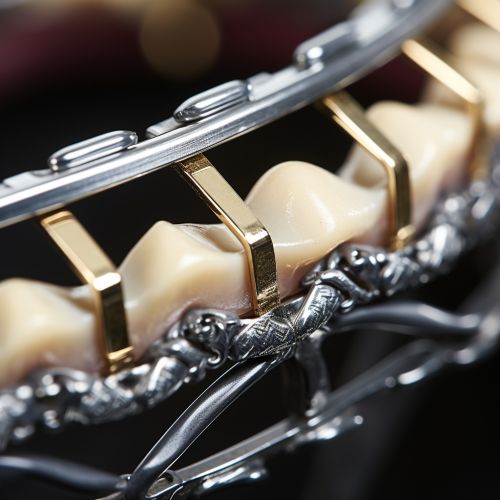Orthodontic Braces
Introduction
Orthodontic braces are devices used in orthodontics that align and straighten teeth and help position them with regard to a person's bite, while also aiming to improve dental health. They are often used to correct underbites, as well as malocclusions, overbites, open bites, deep bites, cross bites, crooked teeth, and various other flaws of the teeth and jaw. Braces can be either cosmetic or structural. Dental braces are often used in conjunction with other orthodontic appliances to help widen the palate or jaws and to otherwise assist in shaping the teeth and jaws.


Types of Braces
There are several types of orthodontic braces available, including traditional metal braces, ceramic braces, lingual braces, and clear aligners such as Invisalign.
Traditional Metal Braces
Traditional metal braces are made from high-grade stainless steel and utilize metal brackets and archwires to move the teeth into their proper positions. They are the most common type of braces used in orthodontics, and have evolved over time to become smaller, more comfortable, and more effective.
Ceramic Braces
Ceramic braces function in the same way as traditional metal braces, but are made from a clear or tooth-colored ceramic material to blend in with the natural color of the teeth. This makes them less noticeable than metal braces, making them a popular choice for adults and older teenagers.
Lingual Braces
Lingual braces are similar to traditional metal braces, but are placed on the back of the teeth (lingual side) instead of the front. This makes them invisible from the outside, but they can be more difficult to clean and adjust than traditional braces.
Clear Aligners
Clear aligners, such as Invisalign, are a series of clear, removable aligners that gradually move the teeth into their correct positions. They are virtually invisible and can be removed for eating, drinking, brushing, and flossing.
Procedure
The procedure for getting braces involves several steps, including initial consultation, application of braces, regular adjustments, and finally, removal of braces and potentially the use of a retainer.
Initial Consultation
During the initial consultation, the orthodontist will examine the patient's teeth and jaws, take X-rays and impressions, and discuss treatment options. The orthodontist will then create a treatment plan tailored to the patient's specific needs.
Application of Braces
The application of braces involves attaching the brackets to the teeth with a special adhesive, and then threading the archwire through the brackets. The archwire is then tightened to begin the process of moving the teeth. This procedure is typically painless, but the patient may experience discomfort in the days following as the teeth begin to move.
Regular Adjustments
Once the braces are on, regular adjustments are necessary to continue moving the teeth into their correct positions. These adjustments involve tightening the archwire, and may also involve replacing worn-out rubber bands, adding springs or chains, or other procedures to continue the tooth movement.
Removal of Braces and Retention
Once the teeth have been moved into their correct positions, the braces are removed and a retainer is often used to keep the teeth in place while the jawbone heals around them. The retainer is typically worn full-time for a period of time, and then only at night.
Risks and Complications
While braces are generally safe and effective, they do come with some risks and potential complications. These can include tooth decay, gum disease, shortening of root lengths, loss of correction, and in rare cases, loss of teeth. Regular dental check-ups and good oral hygiene can help mitigate these risks.
Costs and Insurance
The cost of braces can vary widely depending on the type of braces, the complexity of the treatment, and the geographic location. Insurance coverage for braces also varies, with some plans covering a portion of the cost and others not covering orthodontic treatment at all.
Conclusion
Orthodontic braces are a common and effective treatment for correcting a variety of dental and jaw abnormalities. While they can come with some risks and potential complications, the benefits of braces, including improved dental health and aesthetics, often outweigh these risks.
